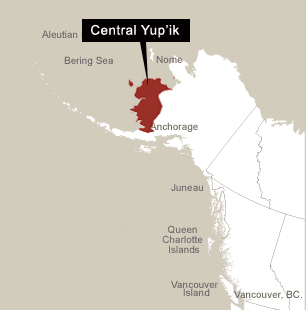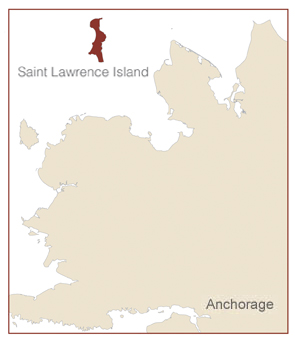
“The southwest Alaska Natives are named after the two main dialects of the Yup’ik language, known as Yup’ik and Cup’ik. The estimated population, at the time of contact, was: Nunivak 500, Yukon-Kuskokwim 13,000 and Bristol Bay 3,000. The Yup’ik and Cup’ik still depend upon subsistence fishing, hunting and gathering for food. Elders tell stories of traditional ways of life, as a way to teach the younger generations survival skills and their heritage.
Many of today’s villages were ancient sites that were used as seasonal camps and villages for subsistence resources. Historically the Yup’ik and Cup’ik people were very mobile, traveling with the migration of game, fish and plants. The ancient settlements and seasonal camps contained small populations, with numerous settlements throughout the region consisting of extended families or small groups of families.
All males in some Yup’ik/Cup’ik communities lived in a qasgiq, or men’s house/community center. Boys old enough to leave their mothers joined male relatives in the qasgiq, where they lived, worked, ate, bathed, slept and learned how to be men. Women prepared and brought food to the qasgiq. Ceremonies, singing, dancing and events usually occurred in the qasgiq, thus making it a community center.
Women and children lived in an ena, which had architectural features similar to the qasgiq, although the qasgiq was twice as large. Bearded seal or walrus intestine provided a removable “skylight” window. Like most other winter dwellings, the qasgiq and the ena shared the distinctive, partially semi-subterranean winter entrance passageway – which in the ena also provided space for cooking.
Technology was highly adapted to survival in the sub-arctic environment, and was fine-tuned through the centuries by trial and error. Technology was mostly geared toward the marine environment along the coast and more riverine habitats in the delta regions.
Women’s important household items included the versatile, fan-shaped, slate knife (uluaq), stone seal-oil lamp and skin sewing implements made from stone, bone and walrus ivory. Men’s tools were associated with hunting and were elaborately decorated with appropriate spiritual symbols to aid in hunting success. These items included a variety of spears, harpoons, snow goggles, ice cane, and bow and arrows for hunting and warfare.”
Source: Text Copyright of the Alaska Native Heritage Center website.

